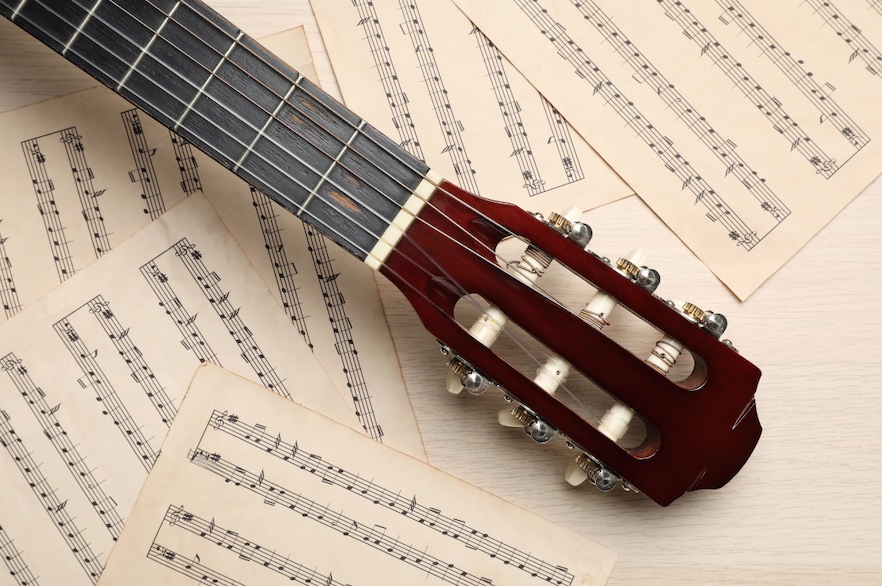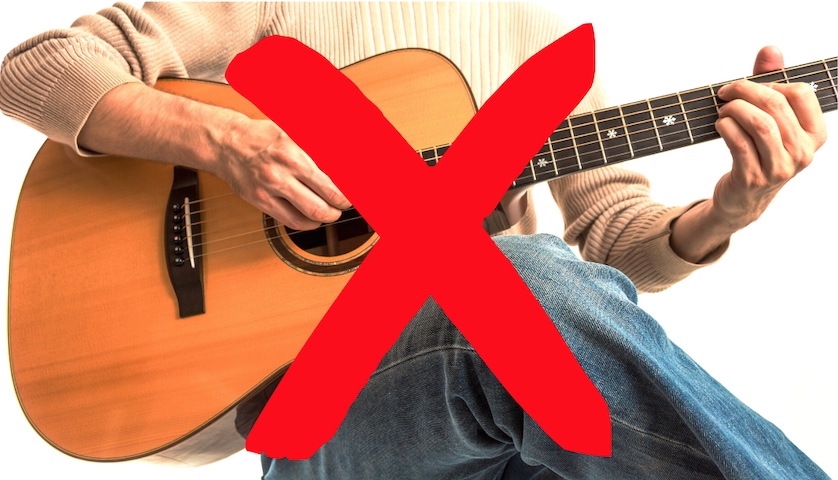Fix Your Rhythm And Timing On The Guitar With Just 5 Minutes A Day!
By Simon Candy
 Do you ever find yourself struggling to play a song or riff on your guitar, even though you have the notes down?
Do you ever find yourself struggling to play a song or riff on your guitar, even though you have the notes down?
You might try playing it faster, but it still doesn't sound right.
This can be a frustrating experience for many guitar players, including myself when I first started learning.
What I eventually realized was that my rhythm and timing on the guitar needed work.
Although I was playing all the right notes, I wasn't placing them in the correct spots, which is why the song or riff didn't sound right. Essentially, I lacked the ability to play my guitar in time.
Understanding how to play your guitar in time is essential for your musical growth. Although it may not seem like the most exciting topic, focusing on rhythm and timing can greatly enhance your guitar skills and lead to significant improvement.
In this article, you learn how to dramatically improve your timing and rhythm on the guitar, and it won’t take any more than 5 minutes of your day.
Why You Struggle To Play Your Guitar In Time
You can think of timing as the glue that holds everything that you play on your guitar together. It will make or break your playing and many people struggle with it, sometimes not even aware that it is a problem.
The reason why playing your guitar in time can be a struggle is because far too often your focus tends to be on what notes to play, and not WHEN to play these notes.
The Rhythm and timing of a song tend to be something that you think will happen by default once you have the notes and chords down. This is not true, and as a result, it is the cause of many guitar playing problems and frustrations.
The Rewards Of Having Great Rhythm And Timing
The exercises that are presented in this article are simple yet very effective if done regularly.
As a result, you will notice a significant improvement in your sense and awareness of time. You will start to "feel" time rather than having to "think" about it.
The ultimate goal is to transition from having to "think" about where the beat is and where the notes on the guitar are played, to "feeling" them.
Once achieved, playing the guitar will become much more enjoyable. No longer will playing in time be a challenge. You will be able to play your favourite songs with greater ease and learn them much faster.
Put Your Guitar Down. You Won’t Be Needing It
 Instead of focusing on a specific task, let's concentrate on improving your rhythm and timing in a broader sense. This will allow you to effortlessly play riffs, licks, chords, or any song you desire.
Instead of focusing on a specific task, let's concentrate on improving your rhythm and timing in a broader sense. This will allow you to effortlessly play riffs, licks, chords, or any song you desire.
The objective is to enhance your overall perception and awareness of time.
Surprisingly, you can practice playing in time without a guitar. It's preferable to do so without having a guitar in your hands since it eliminates distractions. We should approach it like a drummer, concentrating only on rhythm, not pitch.
Another advantage of practising rhythm and timing away from the guitar is that you can do it anywhere, anytime. Even if you have a brief 2-minute break, you can utilize it to improve your timing and, as a result, your overall guitar playing.
Warning:The following drills may seem very simple, and you may think that you are above this and don’t need to do them. This is a common and very costly assumption that people make time and time again. No pun intended :) Don’t be one of them. Whether you are new to guitar, or you have been playing for a while, the following exercises will help your rhythm and timing and by extension, your guitar playing in a great way.
Seeing that 4/4 is the most common time, I am going to use it in the exercises below, but know that you can use other time signatures if you wish. Also, I highly recommend using a metronome when working on your timing. You will still benefit doing the following exercises without one, however using a metronome will dramatically improve your timing by making sure that you keep a consistent tempo and don’t speed up or slow down.
If you have not used a metronome before, or even if you have, check out this video where I take you through 5 tips and tricks for practising guitar with a metronome: (you can check it out after doing the exercises in this article)
Let’s Begin . . .
So to start simply count 1, 2, 3, 4, 1, 2, 3, 4 etc
If you are using a metronome it would be one count to each click.
Once you have a steady count going, start to tap on the “1” beat only. So it would be one tap to every 4 beats (clicks). Here is the count with the beat you are tapping highlighted:
1, 2, 3, 4, 1, 2, 3, 4 etc
Next, tap once to every two beats like this:
1, 2, 3, 4, 1, 2, 3, 4 etc
Then one tap to every beat like this:
1, 2, 3, 4, 1, 2, 3, 4 etc
Make sure you are counting each beat aloud when doing this. This is vitally important in developing great timing and rhythm.
If you count aloud now, you won’t need to down the track. It is a means to an end as you will start to “feel” the beat instead.
Time To Divide The Beat
Next, lets divide the beat you are counting into some common divisions that you will come across in your everyday guitar playing.
You can divide the beat into two by tapping twice to each click of the metronome and counting:
1 + 2 + 3 + 4 + etc
or you can tap three times to each click of the metronome and count:
1 + a 2 + a 3 + a 4 + a etc
and finally, four times to each click of the metronome and count:
1 e + a 2 e + a 3 e + a 4 e + a etc
These are the basic divisions of the beat in music. Counting and tapping them out, especially to a metronome, will provide you with a very solid foundation for your rhythm and timing skills.
Mixing Up Your Divisions For Better Rhythm And Timing
Once you have a good hold on each division of the beat in the above exercises, you can then start to create some variety in your rhythms by mixing them up. Realistically this is how it will be. Most rhythms that you come across in your music will be combinations of different divisions of the beat.
So for example you could count and tap the following:
1 + 2 e + a 3 + a 4 + etc
or how about this one:
1 e + a 2 + 3 e + a 4 + etc
Get the idea?
There are many possible combinations, and to develop a great sense and awareness of rhythm and timing you should create your own and count and tap them everyday.
In fact, you only need to dedicate 5 minutes a day to doing this and you will see great results! Remember too that you can do it anywhere, anytime because you do not need your guitar.
Another thing worth mentioning here is the ability to tap your foot on the beat as you do the exercises above and when you are playing guitar in general.
Tapping your foot allows you to keep time when playing.
Watch the video below to learn how to tap your foot on the beat while playing guitar.
You will be taken through 3 levels that increase in difficulty to get to the point where you can have your foot automatically tapping on the beat while playing anything on guitar:
Learn how to fully maximize your new found rhythm and timing skills by turning your acoustic guitar into a drum using these essential Percussive Guitar Techniques